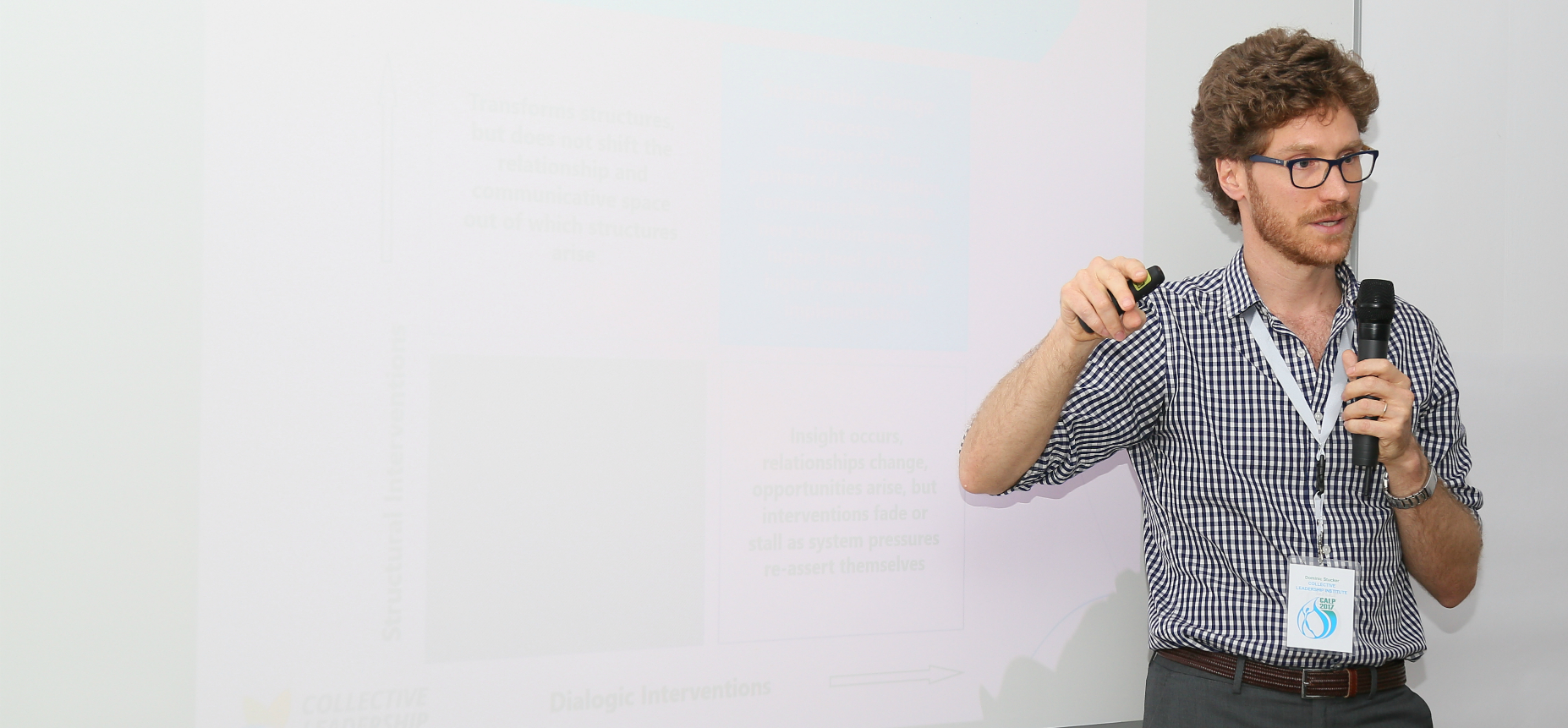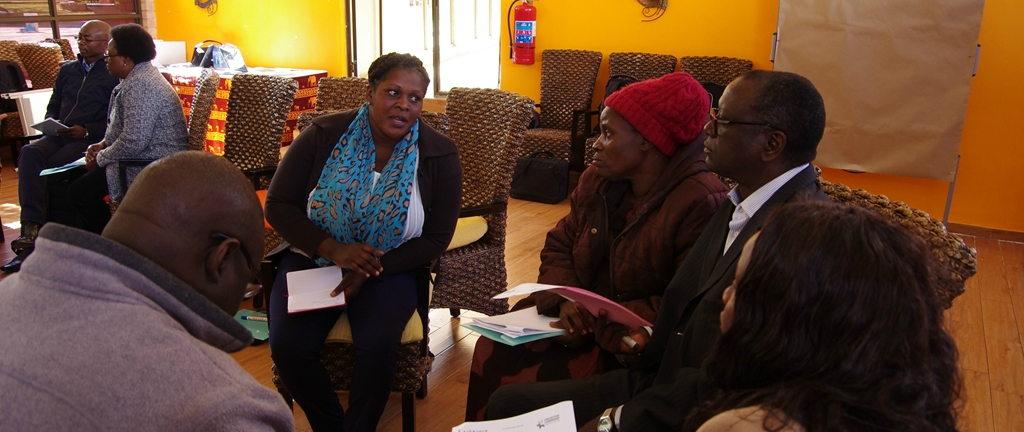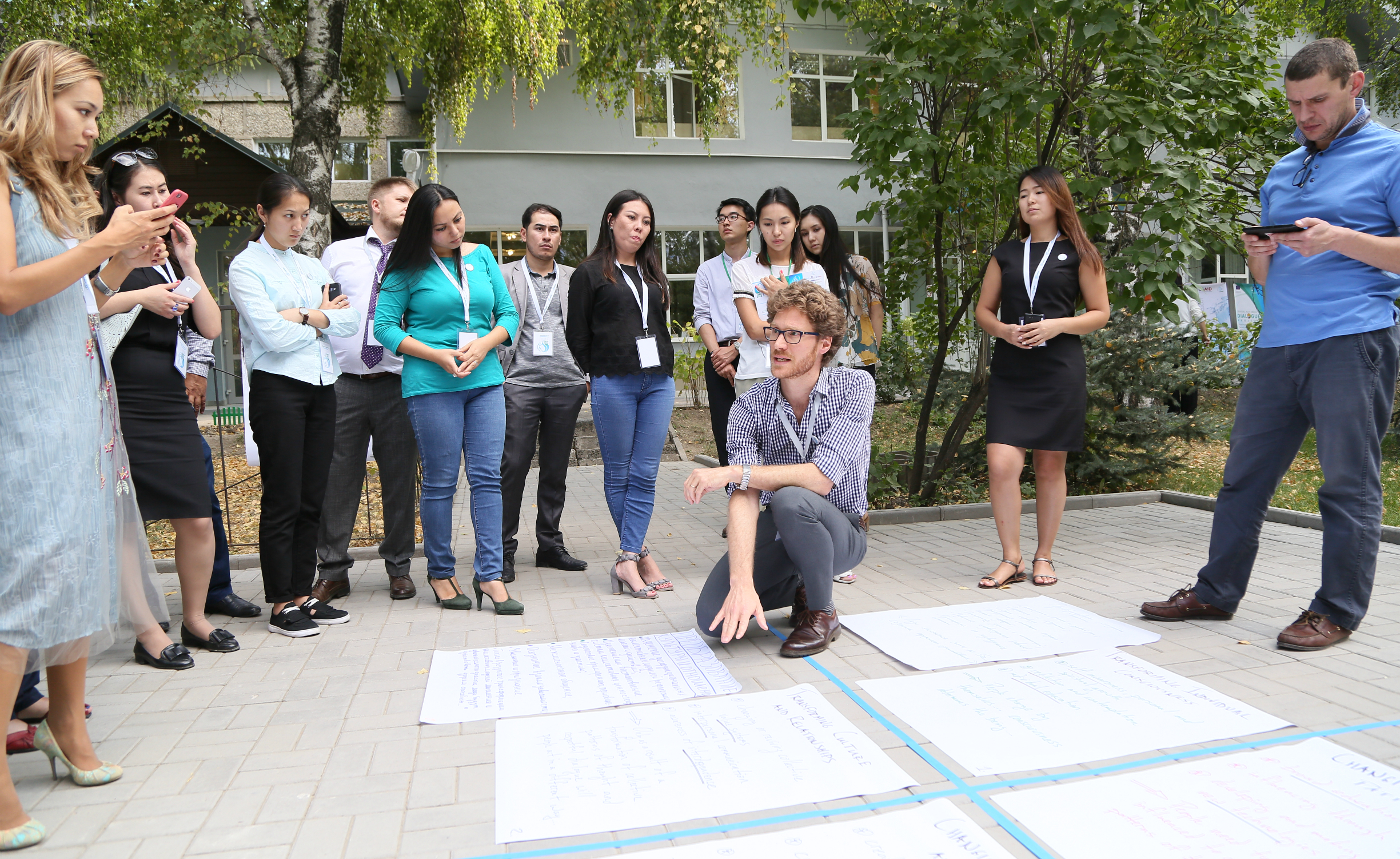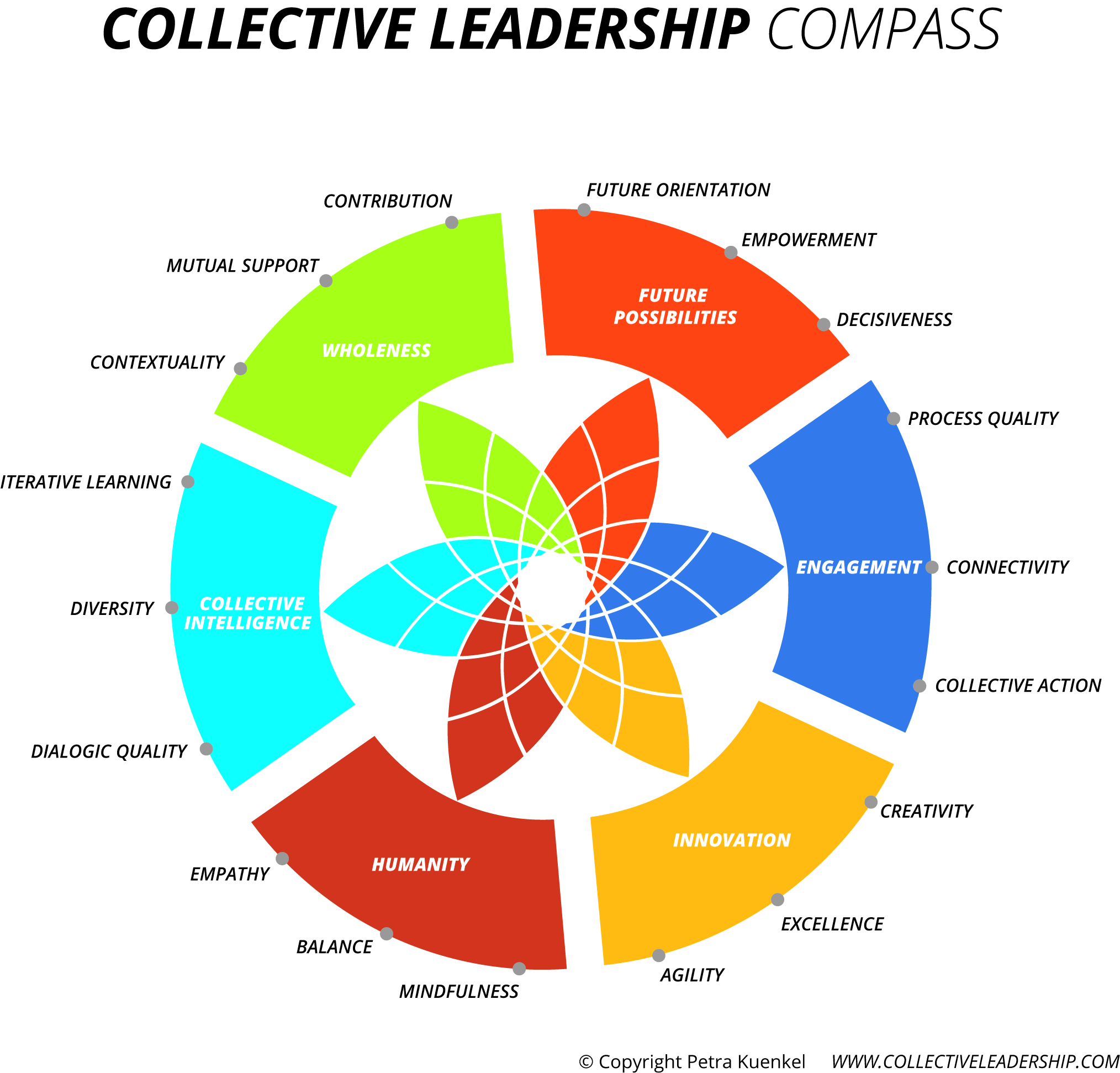“Wherever you are in the hierarchy, whatever sector you are coming from: based on your experiences, competencies, and care, you can contribute” – an interview with Dominic Stucker
From September 11-19 in Almaty, Kazakhstan, CAREC hosted the Eighth CALP – Central Asian Leadership Programme on Environment for Sustainable Development. In the course of active discussions with international and regional experts, young specialists from various fields considered the advantages of regional cooperation on green economy, water management, and energy.
To enhance the interaction between the participants and to increase dialogue and collaboration capacities, the invited facilitators integrated active workouts and exercises into the programme. Dominic Stucker, coach for collective leadership, framed several of these conversations.
-
Dominic is a Managing Partner and Lead Faculty of the Collective Leadership Institute, a non-profit social enterprise based in Germany, South Africa, and the United States. With over 15 years’ experience as a manager, coach, facilitator, and researcher, he is an action-oriented collaborator who convenes diverse teams to address pressing sustainability challenges. While he was here, we took the opportunity to talk about leadership and his experience during CALP.

- Can you please briefly explain for our readers, what does collective leadership mean and what does the Collective Leadership Institute do?
- Sure. The Institute was founded in 2005 in Germany. We are a non-profit social enterprise with offices in Germany, South Africa, and the United States. The focus of our work is scaling collaboration capacity for implementation of the Sustainable Development Goals.
- And why collective leadership instead of just leadership?
- The premise for collective leadership is that the challenges we face are unprecedented and complex; we have to come up with new solutions. We have to be quite innovative and agile. A paradigm shift into collective leadership is needed – and happening – to address the challenges that we are facing now. There is no one sector, one organization, or one person that has all of the answers. Instead, we build dialogue and collaboration capacity so that teams and organizations can draw on their collective intelligence. Coupled with a commitment to learning through mistakes, such teams are more likely to achieve common goals. Collective leadership means that everyone has an important contribution to make in shaping and achieving a shared vision.
- Please give a concrete example which can explain the approach and players of collective leadership.
- Over the past year, I had the opportunity to work in Lusaka, Zambia[1] on urban water security. CLI worked closely with GIZ’s International Water Stewardship Programme (IWaSP) and local Zambian leaders on the Lusaka Water Security Initiative or LuWSI for short. We helped people on the ground come into high-quality dialogue and collaboration across sectors, working toward a vision of a healthy and prosperous city. In terms of water security, of course, there are relevant mandates among public sector agencies that are responsible - the Ministry of Water, in particular.
-
But there is a further set of players who are also concerned with access to water and water sanitation, including from the private sector. For example, business leaders noticed that many employees were coming to work sick, in large part because 70 percent of the population in Lusaka doesn’t have proper sanitation infrastructure. So, there is a point when businesses think: “Wait a minute. We are not being as productive as we could be.” That’s how some became interested in collaboration with the public sector. Other businesses, such as a national beer brewery, are directly impacted by lack of quality water because it is essential for their product or production processes.

And importantly, the communities - often represented by NGOs, civil society organizations – they know the reality on the ground and they are struggling in different ways. We bring them and their voices into what we call a multi-stakeholder “Collaboration Ecosystem.” At the heart of a system like that, there is a jointly developed, shared vision - in this case for water security in Lusaka. The idea is not that it is only the people in the positions of formal leadership that move things forward. Each person - once that shared vision has been co-created - can contribute to make it happen. Wherever you are in the hierarchy, whatever sector you are coming from: based on your experiences, competencies, and care, you can contribute.
- Did you communicate with a LuWSI workgroup in this case or were there workshops?
- In our work in Lusaka, we offered strategic process coaching and facilitation support to help stakeholders in understanding the context, creating resonance for change and getting the first core team together. Some of this was accomplished through explicit capacity building workshops, but most of our work, in this case, was integrated capacity building. Specifically, we supported the development of a shared vision, strategy, and Memorandum of Understanding, as well as the solidification of a LuWSI Steering Board, Technical Working Group, and locally-embedded Secretariat.
In other cases, we do offer two foundational capacity building courses, one on the Art of Stakeholder Collaboration, which is focused on how to really design and lead high quality multi-stakeholder engagement, dialogue, and collaboration processes. The second one is on the Art of Leading Collectively that looks more directly at the pattern of human competencies that are required of collective leaders, teams, organizations, and whole stakeholder systems[2].
- It’s like this for CALP, isn’t it? I saw you gave a lot of sessions with interactive exercises.
- Yes. I had the pleasure to offer three short sessions over the first three days. I started with one that asks the simple question: “Where does change start?” The idea is that if these young professionals are being invited here as leaders, they are expected to help things change and improve. Then “Where does change start?” is a highly relevant question that gets at the underlying theories of change that we each espouse.
One is that change starts with me at an individual level. I need to change myself before I can ask others to change. Another is that change happens at a cultural level through the relationships and values that we share, through ideas that a culture or society has. The third one is about influencing change through information or technology – awareness-raising campaigns, for example. The idea is that “If only people knew, they would change.” And finally, structures and systems – that’s where change starts. This theory of change holds that we need to write or change laws, policies, and budgets; change starts through structural re-organization.
This session gets people into a lively debate. I ask them to choose which theory they most align with and then they have to defend their position, trying to convince others to come to their side. Part of the point is that we all carry these theories of change. It’s like a frame through which we see the world. Other people hold their theory of change very closely, too. We hold them so closely, we don’t even see them. So, I think a key component of being a leader is being self-aware[3].

- That was the first session. What about the second one?
- It was on the Power of Listening. To me, this is also a key aspect of being a leader or being in a leadership role. Listening well is an incredible way to connect with someone and to bring the best out in other people. To describe the exercise – you seat people in pairs, facing one another. One of them is asked to tell a story about something they are really passionate about, but the person who is the listener does everything to show that he or she is not interested. The storyteller generally feels demotivated, disrespected; they don’t feel inspired to share their stories. Obviously, they don’t respond well to not being listened to.
Often when we are talking with people, we are not really listening attentively to them. We are formulating our own ideas and our own response so that we can look smart. You haven’t even finished with your sentence, but I already have my own idea ready to respond.
In the second round, listeners are asked to pay very close attention and show that they are eager for every word the storyteller is sharing. They care, they are interested in what the storyteller has to say. Then the storyteller feels heard, respected and what always happens is that the story becomes better. It becomes richer, more detailed, more animated. They are in the story, they want to continue. And that’s the idea of the power of listening: that I can, as a good listener, empower other people’s stories to be told more fully.
If I can do that as a leader and I am sitting around with teams of people, I will get the best ideas from everyone and together we can come up with something better - much better - than I could come up with on my own. That is the idea of collective intelligence.
- Waiting until you finished, yes?
- Yeah.
People are often scared of silence in conversations. There is a nice quote from Jiddu Krishnamurti, an Indian philosopher, and it’s largely about paying attention while you are listening. Having the capacity for silence in a conversation is actually a very good thing. If you say something to me and there’s a pause that might mean I’m trying to fully take in what you said and I might say “Wait a minute, let me think about that.” I’m allowing what you have to contribute to influence my own thinking so that we can get to that collective intelligence in the middle.
It is important to know what good dialogue feels like. The premise is that dialogue is important for all of us in engaging diverse stakeholders, discussing the challenges we are facing, and articulating the vision and goals needed to get where we want to go. That was the second day[4].
Today, I tried to take it up in scale. My final session was an introduction to Navigating Stakeholder Collaboration across the public, private, and civil society sectors. I organized a working group exercise in which participants are broken into these sectoral groups. The idea was for each group to respond to two questions: “What are the interests of my sector in a stakeholder dialogue?” and “What motivates me to act?” Basically, “How do you engage me and keep me engaged in a stakeholder collaboration process?” You get into a conversation, where people in the room are giving ideas and tips to one another on how to engage with their sector. This can be immensely useful, regardless of whether you are working in transboundary water management, renewable energy, or climate change adaptation.
So, in all of my sessions, really, I am not standing there as the all-knowing “expert;” the experts are all the participants. They are speaking from their own experiences, from their own competencies and context. My passion is bringing together teams of such people - who may have never worked together - and help them collaborate in fruitful ways toward some kind of change that they care about.
- In this point, I want to ask whether you feel if there are any differences in your work across countries or are people the same everywhere?
- In general, I know that leadership is still viewed as quite hierarchical in Central Asia. And what can happen in hierarchical contexts is that you wait, there is a delay. In some organizations, you may not feel like you can speak up without your boss having spoken first. I understand that this is sometimes out of respect for age or position, but I hope there will be more and more room for creative and critical thinking, and those young people are given opportunities to express their ideas and questions. I see this happening in positive ways among CALP participants.
If the education system in Central Asia made a bit of a shift, creativity and innovation could be promoted. As I said at the outset of our conversation, we are going to need new ideas. Agility is important. We need people to be able to think in systems, think of the whole. How are we going to teach that? How do we teach critical thinking? We want students to be asking good questions that lead us into a better future.
- Of course, it is a good point, you are naming something that we can really imagine in Africa or in Latin America. So, isn’t it the same in these countries or is there difference?
You are right. These educational challenges are not unique to Central Asia. In fact, I would extend your point to many schools in Europe and North America as well.
For many of the CALP participants, it may be their very first time sitting around a table with young professionals from other Central Asian countries discussing cooperation on environmental issues in a regional context. What I am trying to offer them is an introduction to leading such cooperation collectively.
- Is the collective leadership approach applicable no matter where you work? Or do you still feel a difference when you work here?
- In general, the methodology we have developed is applicable in different contexts. The models and tools we use inherently respect and rely on diversity and local expertise; that’s built into them. CLI and the collective leadership approach always complement the geographic, cultural, and thematic expertise of local leaders and stakeholders with our expertise in building capacity for results-oriented dialogue and collaboration.
- In conclusion, can you please share your ideas about possible CAREC-CLI collaboration?
- First of all, I cannot overemphasize my gratitude for having had the chance to contribute to the CALP this week. It has been a pleasure to interact with all of you. I would very much welcome involvement in 2018, even, if desired, at the level of co-designing and co-facilitating the workshop program. I will be interested to learn how participants evaluated this year’s CALP and would encourage basing any adaptations on their feedback.
I also enjoyed having a conversation with your director, Iskandar-aka, earlier today. We discussed the potential for even deeper collaboration between CAREC and CLI that I hope will bear fruit.

[1] Lusaka is the capital and largest city of Zambia
[2] For more information on LuWSI, visit this website
[3] This exercise is inspired by Ken Wilbur’s Integral Theory, 2003
[4] This exercise was used as an introduction to the Dialogic Practices of voice, listen, respect, and suspend, described by Bill Isaacs in his book Dialogue and the Art of Thinking Together, 1999
